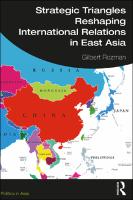Strategic Triangles Reshaping International Relations in East Asia
Proposal review
| dc.contributor.author | Rozman, Gilbert | |
| dc.date.accessioned | 2022-05-18T09:38:36Z | |
| dc.date.available | 2022-05-18T09:38:36Z | |
| dc.date.issued | 2022 | |
| dc.identifier | ONIX_20220518_9781000613957_16 | |
| dc.identifier | ONIX_20220518_9781000613957_16 | |
| dc.identifier | OCN: 1310786916 | |
| dc.identifier.uri | https://library.oapen.org/handle/20.500.12657/54494 | |
| dc.description.abstract | Rozman shows how East Asia’s international relations over three decades can be best understood through the lens of triangles, analyzing relations between the key nations through a series of trilateral relationships. He argues that triangles present a convincing answer to the question of whether we had entered a new era of bipolarity like the Cold War or an age of multipolarity. Triangulation emerged as a dynamic in East Asia in the aftermath of the Cold War and was accelerated in the course of the Xi and Trump administrations. Even as Sino-US competition and confrontation deepened, triangles had a substantial presence. East Asian triangles share an unusual mixture of three distinct elements: deep-seated security distrust, extraordinary economic interdependence, and a combustible composition of historical resentments and civilizational confidence. The combination of the three makes the case for triangularity more compelling, Rozman argues. The legacy of communism, the pursuit of reunification on the Korean Peninsula, and moves to expand beyond the US-Japan alliance have all driven the way triangles have evolved. Only as bipolarity intensified in the 2020s was triangularity losing ground. The degree of turnabout is analyzed for all of the cases considered. Rozman evaluates each key triangle of states in turn and assesses how the relationship impacts the region more widely. This book provides an essential framework for understanding the current state and trajectory of East Asian international relations, for students and policymakers. | |
| dc.language | English | |
| dc.relation.ispartofseries | Politics in Asia | |
| dc.subject.other | Australia | |
| dc.subject.other | China | |
| dc.subject.other | Cold War | |
| dc.subject.other | India | |
| dc.subject.other | Indo-Pacific | |
| dc.subject.other | Japan | |
| dc.subject.other | Korea | |
| dc.subject.other | Russia | |
| dc.subject.other | the Quad | |
| dc.subject.other | USA | |
| dc.title | Strategic Triangles Reshaping International Relations in East Asia | |
| dc.type | book | |
| oapen.identifier.doi | 10.4324/9781003296256 | |
| oapen.relation.isPublishedBy | 7b3c7b10-5b1e-40b3-860e-c6dd5197f0bb | |
| oapen.relation.isFundedBy | Princeton University | |
| oapen.relation.isbn | 9781000613957 | |
| oapen.relation.isbn | 9781003296256 | |
| oapen.relation.isbn | 9781032283135 | |
| oapen.relation.isbn | 9781032283128 | |
| oapen.imprint | Routledge | |
| oapen.pages | 148 | |
| peerreview.anonymity | Single-anonymised | |
| peerreview.id | bc80075c-96cc-4740-a9f3-a234bc2598f1 | |
| peerreview.open.review | No | |
| peerreview.publish.responsibility | Publisher | |
| peerreview.review.stage | Pre-publication | |
| peerreview.review.type | Proposal | |
| peerreview.reviewer.type | Internal editor | |
| peerreview.reviewer.type | External peer reviewer | |
| peerreview.title | Proposal review | |
| oapen.review.comments | Taylor & Francis open access titles are reviewed as a minimum at proposal stage by at least two external peer reviewers and an internal editor (additional reviews may be sought and additional content reviewed as required). |

